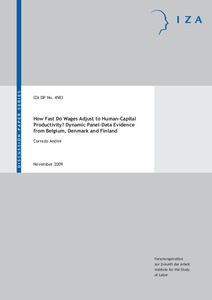How fast do wages adjust to human-capital productivity? Dynamic panel-data evidence from Belgium, Denmark, and Finland
"The standard human-capital model is based on the assumption that the observed wage of an individual is equal to the monetary value of the individual net human-capital productivity, the so-called net potential wage. We argue that this assumption is rejected by the ECHP data for Belgium, Denmark...
| Main Author: | |
|---|---|
| Institution: | ETUI-European Trade Union Institute |
| Format: | TEXT |
| Language: | English |
| Published: |
Bonn
2009
IZA |
| Subjects: | |
| Online Access: | https://www.labourline.org/KENTIKA-19178239124919964119-How-fast-do-wages-adjust-to-hu.htm |
| Summary: | "The standard human-capital model is based on the assumption that the observed wage of an individual is equal to the monetary value of the individual net human-capital productivity, the so-called net potential wage. We argue that this assumption is rejected by the ECHP data for Belgium, Denmark and Finland. The empirical evidence supports a dynamic approach to the Mincer equation where no equality is imposed but an adjustment between observed and potential earnings is allowed to take place over time. Controlling for regressors' endogeneity, individual heterogeneity and time effects, we estimate a dynamic panel-data wage equation and provide measures of the speed of adjustment in Belgium, Denmark and Finland. Further, we elaborate on the implications of a dynamic approach to the Mincer equation for the computation of the return to schooling, including the implication that this return is not independent of labor-market experience, as suggested by Heckman et al. (2005) and Belzil (2007). Finally, we show that a dynamic wage equation can be seen as the solution of a simple wage-bargaining model and argue that a micro-founded model can fit the data better than a simple adjustment model but requires more theoretical assumptions." |
|---|---|
| Physical Description: | 18 p. Digital |

